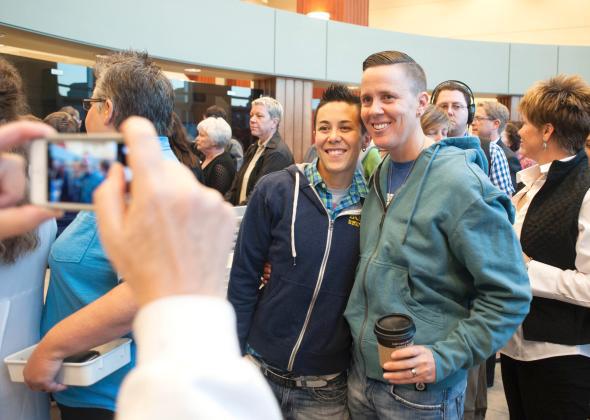On Wednesday, the Supreme Court’s handling of marriage equality officially lurched from surprising and questionable to chaotic and bizarre. Last week, we thought the justices were simply taking the slow boat to marriage equality. It now appears the court has decided to conduct a frenzied game of jurisprudential bumper cars. Over the last three days, the justices have sent states and federal courts on a collision course, changing the rules on a whim, and leaving everyone—from governors and attorneys general to judges and gay plaintiffs—to crash into each other repeatedly and pointlessly. It is madness, it is fruitless, and it must stop now.
The latest pileup arrived on Wednesday, when gay marriage in Nevada went from being illegal to legal to illegal again to legal again—all in the span of less than 24 hours. Here’s the gruesome tale: On Tuesday, the 9th Circuit struck down gay marriage bans in Idaho and Nevada. Overnight, Idaho begged Justice Anthony Kennedy, who oversees the 9th Circuit, to prevent the ruling from taking effect within the state while it readied an appeal. On Wednesday morning, Kennedy did way more than that: He put the entire ruling on hold, meaning gay marriage remained illegal in both Idaho and Nevada.
There was a problem, though. Nevada did not ask to stay the ruling. In fact, Nevada’s governor and attorney general decided not to appeal a pro-gay ruling last year. The state was quite content with the 9th Circuit’s decision, and nobody else had standing to defend the ban on their behalf. On Tuesday night, Nevadans went to bed thinking gay marriage had arrived in their state for good. But Kennedy’s Wednesday morning order ripped Nevada’s gay marriage ban from its shallow grave, reinstating the butchered ban—completely against the wishes of the state. By asking Kennedy to preserve its own ban, Idaho had accidentally defended Nevada’s ban. Marriages within the silver state were halted.
Thus arose the second problem of the day. For better or for worse, one state cannot actually revive another state’s slain law and send its zombielike corpse to stalk down defendants and gnaw away at their newfound rights. Presumably, Kennedy realized this fact at some point around lunchtime, as he issued a second order just hours later, reversing course. “Upon further consideration,” Kennedy wrote, only Idaho’s ban would be granted a reprieve. Nevada’s ban, mercifully, could be shoved back into its resting place, and marriages within the state could continue.
This is not how the law is supposed to work. This is barely even law. But by repeatedly shrugging away the marriage equality question, the Supreme Court has forced us to contend with such chaos. This week’s decisions have theoretically legalized gay marriage in South Carolina, North Carolina, West Virginia, Wyoming, Kansas, Colorado, Nevada, Idaho, Alaska, Montana, and Arizona. Only Colorado has cleanly instituted marriage equality as the new rule of law. Nevada has seen its ban die twice. The other states are acting like nothing has even happened. The Supreme Court is supposed to prevent pandemonium like this. Instead, it has only exacerbated it.
There is only one way for the justices to get out of their current jam: They must take the next gay marriage case that comes to them. The days of waiting idly for a circuit split are over. This mess needs to be cleaned up as quickly as possible. At this point, it’s not just gay couples who are being harmed by the court’s inaction. Every governor and attorney general, every judge and county clerk, deserves to be given a clear view of the law. The Supreme Court has thus far denied everyone—from anti-gay governors to loving gay couples—this basic clarity. We all deserve better.
